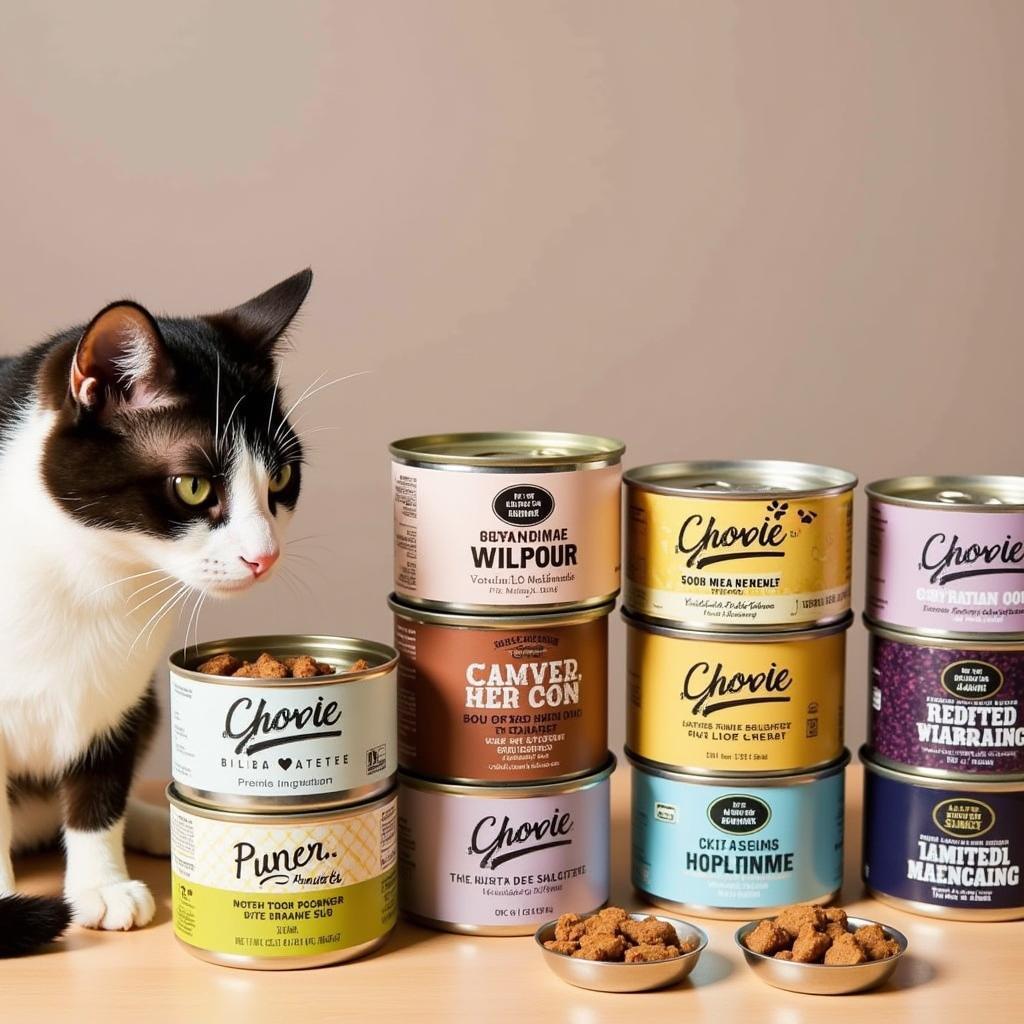Limited Ingredient Canned Cat Food is becoming increasingly popular amongst cat owners seeking to simplify their feline friend’s diet. Whether your cat suffers from food allergies or sensitivities, or you’re simply looking for a more streamlined nutritional approach, understanding the nuances of limited ingredient cat food is crucial. This guide delves into the benefits, considerations, and key features to look for when choosing the best limited ingredient canned cat food for your beloved companion.
 Various Cans of Limited Ingredient Cat Food
Various Cans of Limited Ingredient Cat Food
Why Choose Limited Ingredient Canned Cat Food?
For cats with sensitive stomachs or allergies, identifying the culprit ingredient can be a frustrating and lengthy process. Limited ingredient diets, by virtue of their simplified recipes, make this process easier. They typically focus on a single protein source and a limited number of carbohydrates and other essential nutrients. This makes it significantly simpler to pinpoint any ingredients that may be causing adverse reactions in your cat. Beyond allergy management, some cat owners prefer limited ingredient diets for their overall transparency and perceived purity. Knowing exactly what your cat is consuming can provide peace of mind.
If you’re considering switching your cat to a limited ingredient diet, it’s always best to consult with your veterinarian. They can help you assess your cat’s specific nutritional needs and recommend appropriate food options. Many veterinarians recommend limited ingredient turkey dog food for dogs with similar dietary needs, and similar principles apply to feline diets as well.
Key Ingredients to Look For (and Avoid)
When scrutinizing the label of a limited ingredient canned cat food, look for a clearly identified novel protein source like duck, venison, or rabbit, especially if your cat is dealing with allergies. Common allergens like beef, chicken, and fish are best avoided. Similarly, the carbohydrate sources should be easily digestible and limited in number. Look for options like sweet potato or pumpkin, rather than grains like wheat or corn, which can be problematic for some cats.
What about essential fatty acids and other vital nutrients? A complete and balanced limited ingredient cat food will still include these crucial components. Look for added vitamins and minerals to ensure your cat receives all the necessary nutrients for optimal health. You can even find high-quality options that cater to specific life stages, such as kitten or senior formulas.
“When transitioning a cat to a new diet, gradual introduction is key,” advises Dr. Amelia Parker, a veterinary nutritionist with over 15 years of experience. “Start by mixing a small amount of the new food with the old, gradually increasing the proportion of the new food over a period of 7-10 days.”
Is Limited Ingredient Canned Cat Food Right for My Cat?
While limited ingredient canned cat food can be beneficial for many cats, it’s not a one-size-fits-all solution. If your cat is thriving on a regular diet and doesn’t exhibit any signs of food allergies or sensitivities, switching may not be necessary. K9 natural dog food is an example of a more holistic approach for dogs, and there are similar options available for cats. However, if your cat experiences digestive upset, skin issues, or excessive itching, a limited ingredient diet could be a worthwhile option to explore. Always discuss dietary changes with your veterinarian to ensure they align with your cat’s individual health needs.
What is the difference between limited ingredient and hypoallergenic cat food?
Limited ingredient cat food focuses on a smaller number of ingredients, making it easier to identify potential allergens. Hypoallergenic cat food, on the other hand, contains hydrolyzed proteins, broken down into smaller pieces to minimize the risk of allergic reactions.
How do I transition my cat to limited ingredient canned food?
Gradually introduce the new food over 7-10 days, mixing increasing amounts with your cat’s current food to avoid digestive upset.
How can I tell if my cat is allergic to their food?
Common signs of food allergies in cats include vomiting, diarrhea, itchy skin, hair loss, and ear infections. If you suspect an allergy, consult your veterinarian. They might recommend an elimination diet, native 4 dog food often serves this purpose in canine diets.
In conclusion, limited ingredient canned cat food offers a valuable option for cat owners seeking a simplified and transparent dietary approach. By carefully evaluating the ingredients and consulting with your veterinarian, you can make an informed decision about whether a limited ingredient diet is the right choice for your feline companion’s long-term health and wellbeing. Remember, a healthy cat is a happy cat.
FAQ
- What are the benefits of limited ingredient canned cat food?
- Is limited ingredient cat food suitable for all cats?
- What are some common ingredients in limited ingredient cat food?
- How do I choose the best limited ingredient canned cat food for my cat?
- How much limited ingredient canned food should I feed my cat?
- Are there any potential downsides to feeding my cat limited ingredient food?
- Where can I buy limited ingredient canned cat food?
You may also want to read more about grain free fish dog food and kosher food quebec city.
When needing support, please contact Phone Number: 02437655121, Email: minacones@gmail.com Or visit us at: 3PGH+8R9, ĐT70A, thôn Trung, Bắc Từ Liêm, Hà Nội, Việt Nam. We have a 24/7 customer care team.